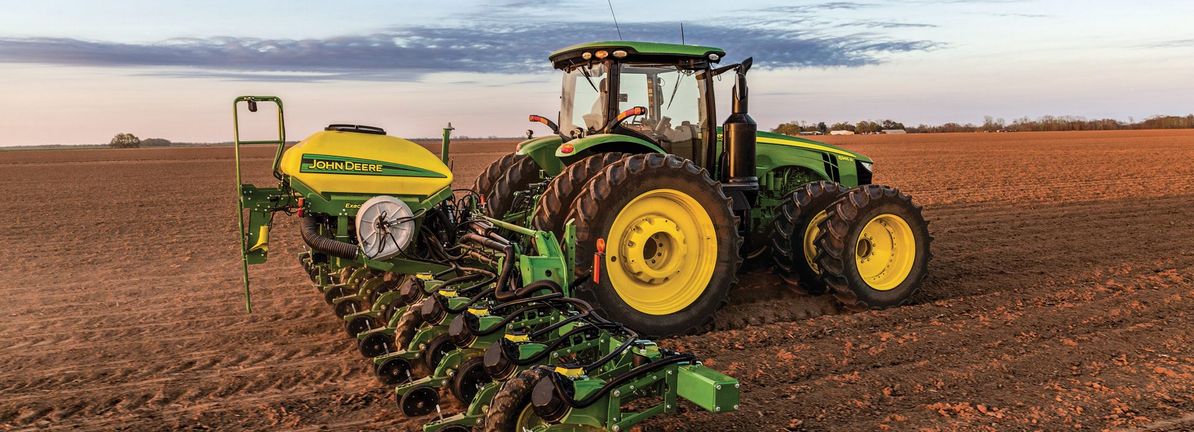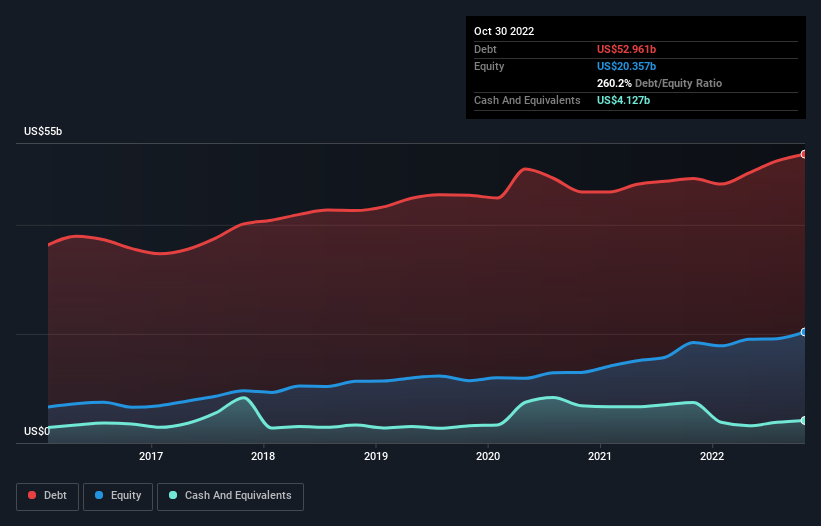
Legendary fund manager Li Lu (who Charlie Munger backed) once said, ‘The biggest investment risk is not the volatility of prices, but whether you will suffer a permanent loss of capital.’ So it might be obvious that you need to consider debt, when you think about how risky any given stock is, because too much debt can sink a company. As with many other companies Deere & Company (NYSE:DE) makes use of debt. But is this debt a concern to shareholders?
Why Does Debt Bring Risk?
Generally speaking, debt only becomes a real problem when a company can’t easily pay it off, either by raising capital or with its own cash flow. In the worst case scenario, a company can go bankrupt if it cannot pay its creditors. However, a more usual (but still expensive) situation is where a company must dilute shareholders at a cheap share price simply to get debt under control. Of course, the upside of debt is that it often represents cheap capital, especially when it replaces dilution in a company with the ability to reinvest at high rates of return. When we examine debt levels, we first consider both cash and debt levels, together.
Check out our latest analysis for Deere
What Is Deere’s Debt?
As you can see below, at the end of October 2022, Deere had US$53.0b of debt, up from US$48.5b a year ago. Click the image for more detail. However, it also had US$4.13b in cash, and so its net debt is US$48.8b.

A Look At Deere’s Liabilities
According to the last reported balance sheet, Deere had liabilities of US$32.9b due within 12 months, and liabilities of US$36.8b due beyond 12 months. Offsetting these obligations, it had cash of US$4.13b as well as receivables valued at US$8.95b due within 12 months. So its liabilities total US$56.6b more than the combination of its cash and short-term receivables.
Deere has a very large market capitalization of US$127.9b, so it could very likely raise cash to ameliorate its balance sheet, if the need arose. But it’s clear that we should definitely closely examine whether it can manage its debt without dilution.
We measure a company’s debt load relative to its earnings power by looking at its net debt divided by its earnings before interest, tax, depreciation, and amortization (EBITDA) and by calculating how easily its earnings before interest and tax (EBIT) cover its interest expense (interest cover). This way, we consider both the absolute quantum of the debt, as well as the interest rates paid on it.
Deere’s net debt is 4.5 times its EBITDA, which is a significant but still reasonable amount of leverage. But its EBIT was about 39.6 times its interest expense, implying the company isn’t really paying a high cost to maintain that level of debt. Even were the low cost to prove unsustainable, that is a good sign. Also relevant is that Deere has grown its EBIT by a very respectable 24% in the last year, thus enhancing its ability to pay down debt. The balance sheet is clearly the area to focus on when you are analysing debt. But ultimately the future profitability of the business will decide if Deere can strengthen its balance sheet over time. So if you’re focused on the future you can check out this free report showing analyst profit forecasts.
Finally, a business needs free cash flow to pay off debt; accounting profits just don’t cut it. So the logical step is to look at the proportion of that EBIT that is matched by actual free cash flow. In the last three years, Deere’s free cash flow amounted to 49% of its EBIT, less than we’d expect. That weak cash conversion makes it more difficult to handle indebtedness.
Our View
Both Deere’s ability to to cover its interest expense with its EBIT and its EBIT growth rate gave us comfort that it can handle its debt. But truth be told its net debt to EBITDA had us nibbling our nails. When we consider all the elements mentioned above, it seems to us that Deere is managing its debt quite well. But a word of caution: we think debt levels are high enough to justify ongoing monitoring. When analysing debt levels, the balance sheet is the obvious place to start. But ultimately, every company can contain risks that exist outside of the balance sheet. For example – Deere has 1 warning sign we think you should be aware of.
When all is said and done, sometimes its easier to focus on companies that don’t even need debt. Readers can access a list of growth stocks with zero net debt 100% free, right now.
Valuation is complex, but we’re helping make it simple.
Find out whether Deere is potentially over or undervalued by checking out our comprehensive analysis, which includes fair value estimates, risks and warnings, dividends, insider transactions and financial health.
Have feedback on this article? Concerned about the content? Get in touch with us directly. Alternatively, email editorial-team (at) simplywallst.com.
This article by Simply Wall St is general in nature. We provide commentary based on historical data and analyst forecasts only using an unbiased methodology and our articles are not intended to be financial advice. It does not constitute a recommendation to buy or sell any stock, and does not take account of your objectives, or your financial situation. We aim to bring you long-term focused analysis driven by fundamental data. Note that our analysis may not factor in the latest price-sensitive company announcements or qualitative material. Simply Wall St has no position in any stocks mentioned.
Source link
